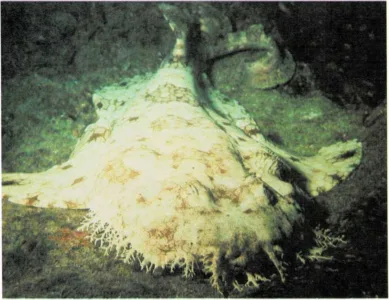Sharks
Most people think of sharks as being only one kind of very big, very
fierce, and rather frightening fish. But there are actually some 350
different kinds of sharks. And they come in all sizes. The giant, but
harmless, whale shark is fifty feet (15 meters) long. The little dwarf
shark is only five inches (12.5 centimeters) long.
Sharks are fish, but they’re different from most fish in several ways.
For one thing, their skeletons aren’t made of bone, as are the skeletons
of most fish. Sharks have a skeleton that is made of cartilage, or what
most people call “gristle.” And a shark’s scales aren’t like the rather
broad, smooth scales of other fish. They’re like millions of tiny
teeth\ This makes a shark’s skin feel very rough. In fact, in past
years, people used sharkskin as sandpaper!
A shark’s gills are different from the gills of other fish. The gills of
other fish are covered, but a shark’s gills are open. They look like
slits on each side of the shark’s body, just behind its head. Most
sharks have five of these slits, but some have six or seven.
Most fish lay a huge number of soft, jelly like eggs. But most sharks
give birth to babies that come out of their mothers’ bodies, as a human
baby does. Some kinds of sharks do lay eggs, but the eggs are not soft.
They are enclosed in hard coverings.
Some kinds of sharks—but not most—are dangerous to humans. People
swimming in the sea have been attacked and injured and killed by them.
However, even the most

These pictures show the size and shape of some different kinds of
sharks. The whale shark is about fifty feet (15 meters) long.
dangerous kinds of sharks will not always attack\’a person. Sometimes
they will, but often they won’t. But if you go swimming in the sea, it’s
best to be careful. Never swim at night, never swim alone, and leave the
water at once, but quietly, if a shark is sighted.
The most \”famous” and dangerous shark is the great white shark. In some
places this shark is called \”the maneater.” In Australia, it’s often
called \”the death shark.” This shark is big, from seventeen to twenty
feet (5.1 to 6 m) long. Its triangular teeth are three inches (7.5 cm)
long, with edges like the blade of a saw!
Great white sharks have been known to attack humans, but they don’t
deliberately hunt for people. They will eat almost anything— large
fish, porpoises, seals, smaller sharks, sea turtles, dead animals they
find in the water, and garbage that has been thrown overboard from
ships.
Despite its name, the white shark isn’t pure white. Its back may be
brown, blue, gray, or black. Only its sides and belly are a dingy white.
Another big and well-known shark is the tiger shark. It has this name
because it has dark
brown stripes, like the\’stripes of a tiger, on the upper part of its
brownish body. It, too, is a dangerous shark. It has been known to
attack people even when they were swimming in very
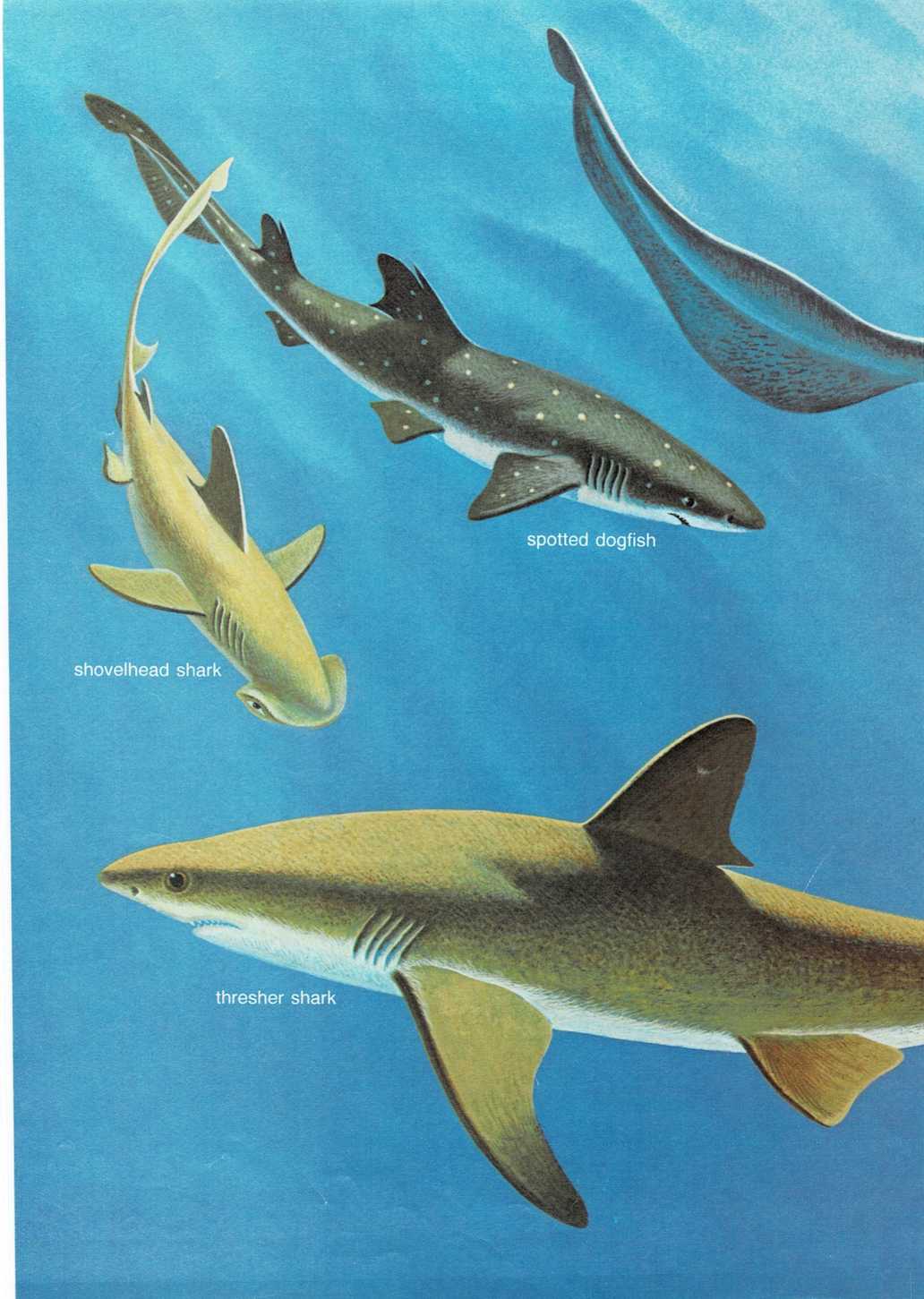
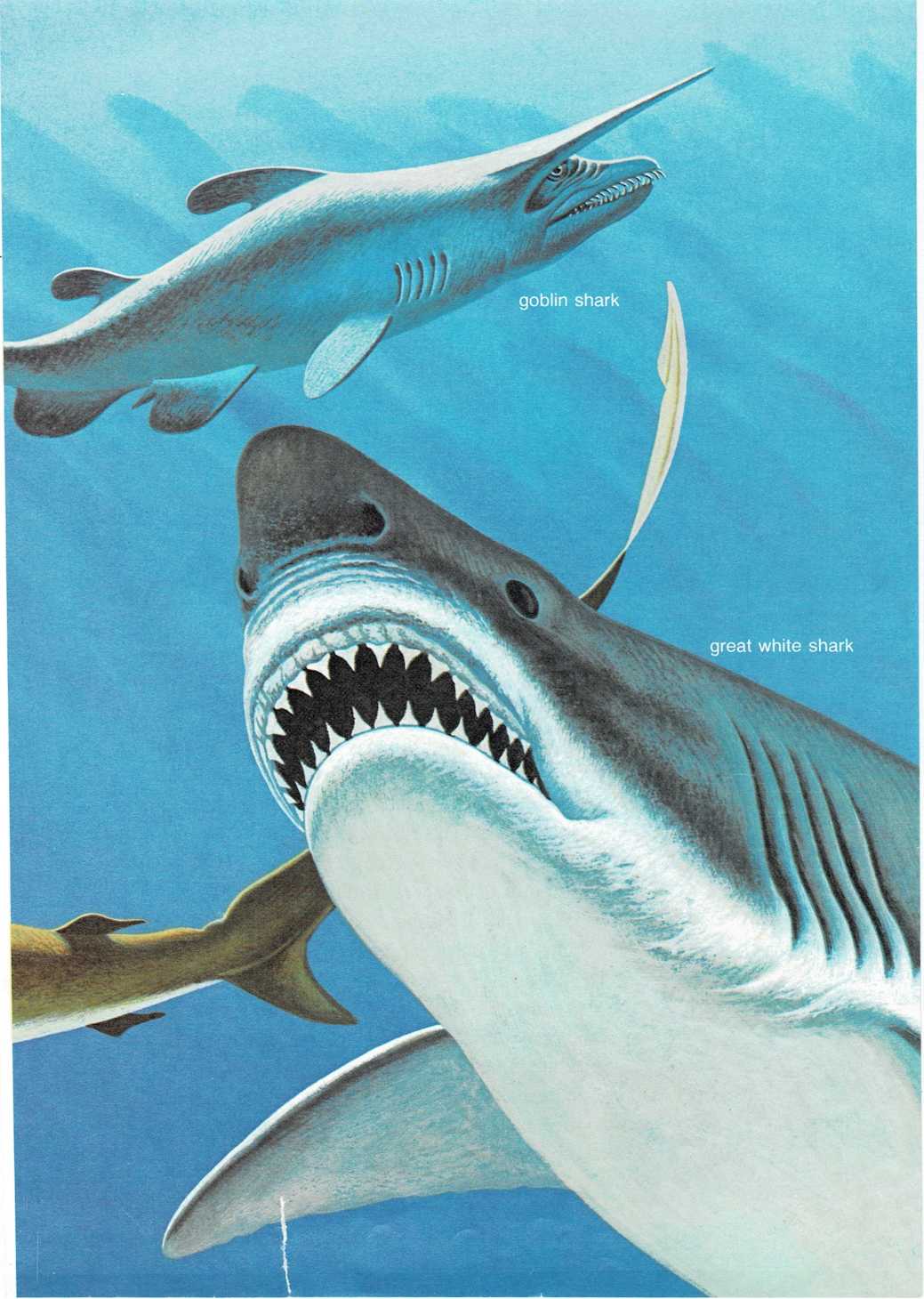
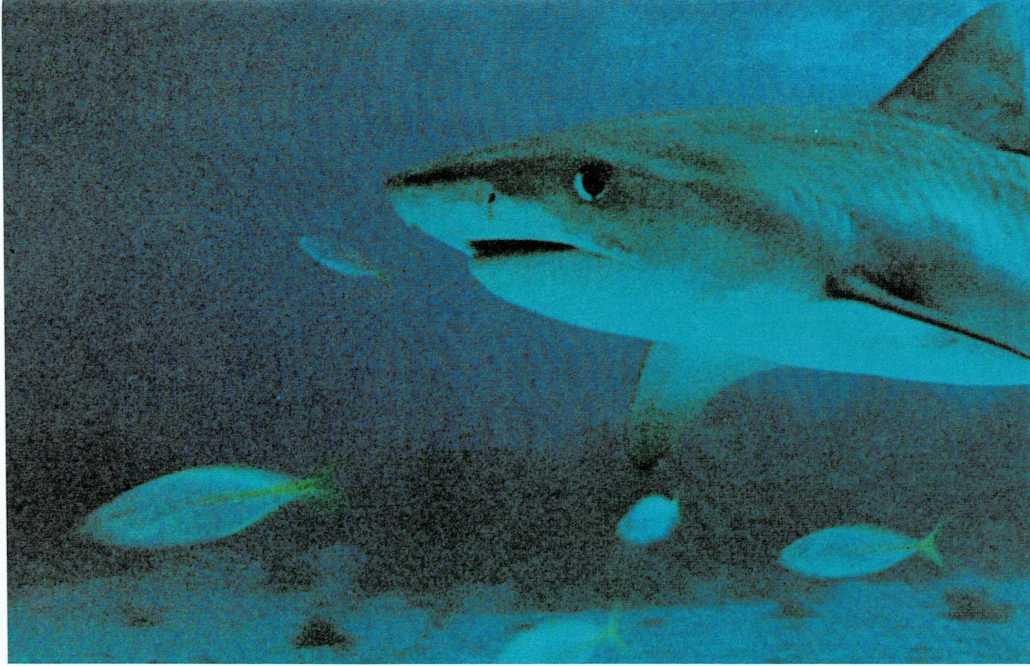
shallow water, near shore. Most tiger sharks are about ten feet (3 m)
long, but some are as much as eighteen feet (5.4 m) long.
Tiger sharks apparently don’t care what they eat. They will snap up
animals of all kinds, as well as almost anything they find in the water.
Tiger sharks that have been caught have been found to have eaten such
things as a leather wallet, a can of salmon, a large coil of copper
wire, cardboard boxes, nuts and bolts, and even a wooden drum.
Another big and dangerous shark is the strange-looking hammerhead. Its
body is shaped much like the body of a tiger shark or white shark, but
its head is very different. Where its nose ought to be, there is a kind
of tube that sticks out on both sides of its head. Its eyes are at the
ends of the tube. The tube
tiger shark
resembles the head of a hammer, which is why the shark has the name
\”hammerhead.”
There are twelve kinds of hammerhead sharks. Each kind has a slightly
differentlooking head. On some kinds, the front of the head is broad and
shaped like a garden spade. These sharks are called \”shovelheads.”
The biggest kind of hammerhead shark is about fifteen feet (4.6 m) long.
It is known as the great hammerhead. The smallest are four to five feet
(1.2 to 1.5 m) long.
The smaller hammerheads do their hunting close to the sea bottom and eat
mainly crabs and barnacles. Medium-sized hammerheads go after large
fish—and often after smaller hammerheads!
The great hammerhead eats all sorts of things. But it seems to be
especially fond of
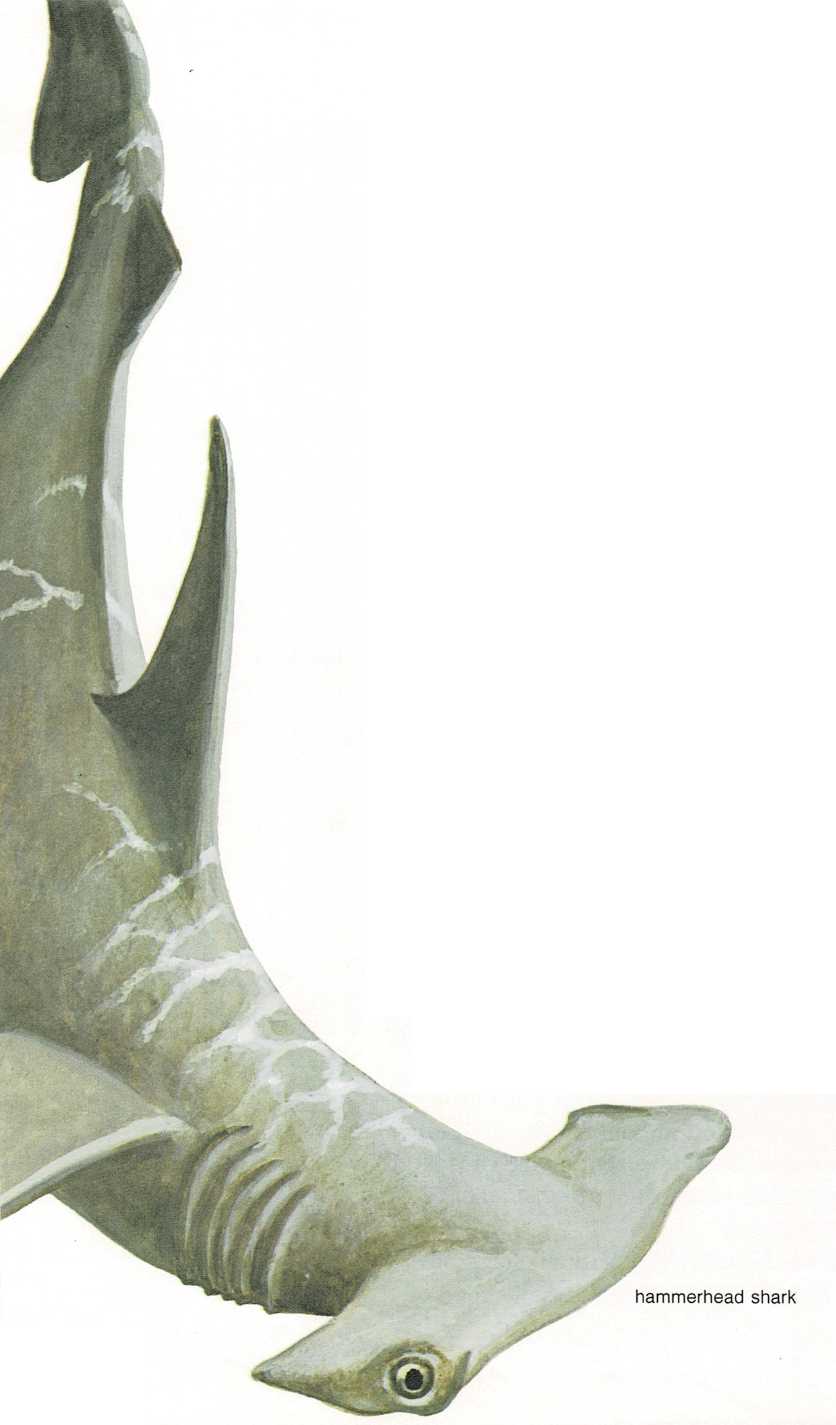
the flat-bodied fish called a ray. It pays no attention to the fact that
most kinds of rays have long tails with poisonous stickers, or spines,
in them. The rays stick these spines into creatures that bother them.
One large hammerhead that was caught had fifty-four of these poisonous
spines sticking in its head and body. The spines didn’t seem to bother
the shark a bit!
The larger kinds of hammerheads are dangerous to humans. People swimming
in the sea in several parts of the world have been attacked, and in some
cases killed, by hammerhead sharks.
The hammerhead shark may have a strange- looking front end, but the
shark called a thresher has a strange-looking back end. The thresher is
a big shark, about twenty feet (6 m) long. But half that length is made
up of an enormously long, curved tail. The thresher uses this tail to
get its food.
When a hungry thresher sees a school of small fish, such as herring or
mackerel, it moves in close and begins to swim swiftly around them. It
lashes the water with its long tail, using it like a whip. This causes
the fish in the school to bunch together. Then the thresher shark
charges into them, biting and gulping until it has eaten its fill.
Thresher sharks also use their tails to stun fish that are swimming by
themselves. A thresher shark was once seen swimming toward an injured
sea gull that was floating on the water. With a slap of its tail, the
shark killed the gull, then ate it.
The whale shark, the biggest of all sharks, is also the biggest of all
fish. Most whale sharks are at least fifty feet (15 m) long, and some
may be as much as sixty feet (18 m) long. In spite of their size, they
eat only very small fish and squid, and the tiny, drifting plants and
animals called plankton. These big sharks are so harmless people can
swim right up to them and touch them. They will even let people hitch a
ride on their back!
The second biggest shark is the basking shark. It measures up to forty
feet (12 m) in length. Also a harmless creature, the basking shark eats
only plankton. Of course, it takes a lot of plankton to fill such a
big creature’s stomach, so a basking shark spends most of its time
eating. It swims slowly along with its mouth open. At the back of its
throat is a kind of bony \”sieve” that strains the plankton out of the
water.
The wobbegong is a shark that spends most of its time lying on the sea
bottom, waiting for crabs and other creatures to come up to it and be
eaten. You might wonder why a crab would do such a foolish thing, and
the answer is that the animals the wobbegong eats do not know the shark
is there! You see, it wears a disguise. It looks just like a clump of
rocks sitting in a patch of waving seaweed.
Wobbegongs have rather lumpy bodies and bumpy, splotchy-colored skin
that looks like rock. Around the wobbegong’s head and mouth are little
flaps of skin that look like bits of seaweed. When a fish or crab comes
up to the \”rock” to look for a worm or other small creature among the
\”seaweed,” the wobbegong’s big mouth suddenly opens up. And that’s the
end of the fish or crab. The biggest wobbegongs are about ten feet (3 m)
long.
Sharks are usually found in warm waters. But there is one kind of shark
that lives in the cold, cold waters near the North Pole! This shark is
quite different from sharks such as the fast-moving white shark, tiger
shark, and others of that sort. It moves so slowly that it seems half
asleep. This is why it is usually called a sleeper shark.
The sleeper shark is about eight to twelve feet (2.4 to 3.6 m) long. It
has a stout, clumsy body and a rather small head. These sharks seem to
prefer to eat dead animals they find in the water. Perhaps this is
because they don’t have to chase such things. Sleepers also eat seals.
But it’s a mystery how such a slow- moving creature can catch a
fast-moving seal.
Several kinds of sharks live in very deep water and are not often seen
at the surface. One of these, the lizard shark, looks more like a small
sea serpent than a shark! It has a head like a lizard, and a thin, snaky
body about six feet (1.8 m) long. This shark has six gill slits, with
lacy, curly edges, like frills. So, it is also known as a frilled shark.
The lantern shark is also a deep-sea shark that lives far down in the
darkness. It got its

wobbegong shark
name because the bottom part of its body glows like a lantern, with a
bright greenish light. The lantern shark is only about twelve inches (30
cm) long. It eats small squid and shrimp.
These are only a few of the many kinds of sharks there are. There are
also sharks called catsharks and sharks called dogfishes. There are
swell sharks, which got their name because they puff themselves up like
balloons. And there are goblin sharks, angel sharks, and many others.
As you can see, a shark isn’t necessarily a big, fast, dangerous fish
with sharp teeth. Sharks are a big \”family.” They don’t all look alike
or live in the same way.

